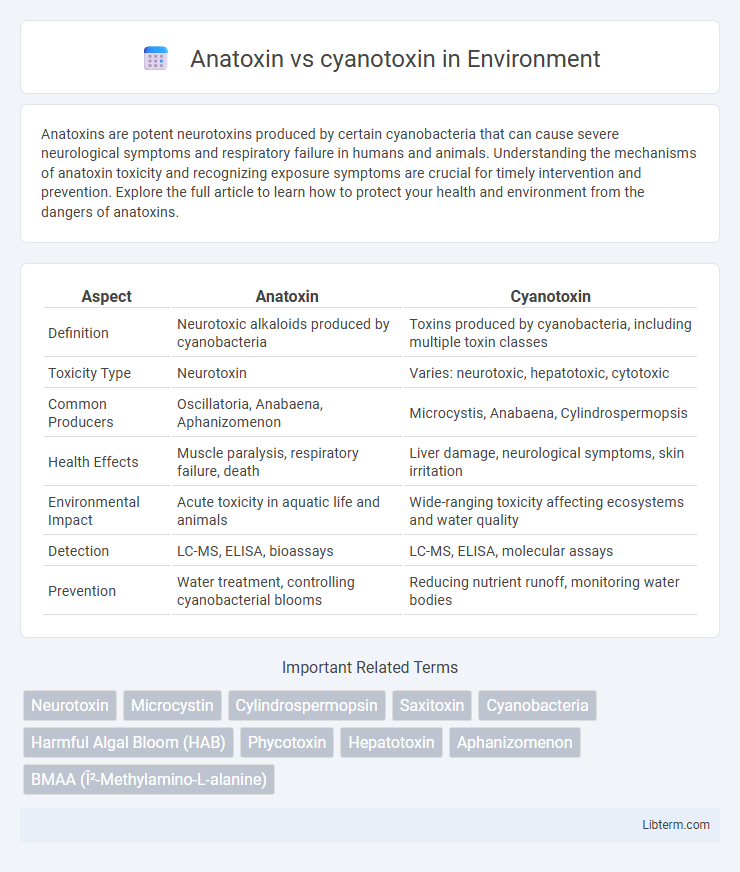Anatoxins are potent neurotoxins produced by certain cyanobacteria that can cause severe neurological symptoms and respiratory failure in humans and animals. Understanding the mechanisms of anatoxin toxicity and recognizing exposure symptoms are crucial for timely intervention and prevention. Explore the full article to learn how to protect your health and environment from the dangers of anatoxins.
Table of Comparison
| Aspect | Anatoxin | Cyanotoxin |
|---|---|---|
| Definition | Neurotoxic alkaloids produced by cyanobacteria | Toxins produced by cyanobacteria, including multiple toxin classes |
| Toxicity Type | Neurotoxin | Varies: neurotoxic, hepatotoxic, cytotoxic |
| Common Producers | Oscillatoria, Anabaena, Aphanizomenon | Microcystis, Anabaena, Cylindrospermopsis |
| Health Effects | Muscle paralysis, respiratory failure, death | Liver damage, neurological symptoms, skin irritation |
| Environmental Impact | Acute toxicity in aquatic life and animals | Wide-ranging toxicity affecting ecosystems and water quality |
| Detection | LC-MS, ELISA, bioassays | LC-MS, ELISA, molecular assays |
| Prevention | Water treatment, controlling cyanobacterial blooms | Reducing nutrient runoff, monitoring water bodies |
Understanding Anatoxin and Cyanotoxin: Key Differences
Anatoxins are potent neurotoxins produced primarily by certain cyanobacteria species, causing rapid paralysis by targeting nerve transmission, while cyanotoxins represent a broader group of toxins including hepatotoxins, neurotoxins, and dermatotoxins from various cyanobacteria. Anatoxin-a, a well-known neurotoxin, disrupts acetylcholine receptors, leading to acute neurological damage, whereas other cyanotoxins like microcystins mainly affect liver function causing hepatotoxicity. Understanding these distinctions is critical for water safety monitoring and managing cyanobacterial bloom risks to prevent toxic exposure in humans and animals.
Chemical Structures and Properties
Anatoxins are bicyclic alkaloids with a rigid structure characterized by a saturated bicyclic guanidine moiety, leading to high affinity for nicotinic acetylcholine receptors and rapid neurotoxic effects. Cyanotoxins comprise diverse chemical families, including cyclic peptides like microcystins with hepatotoxic properties and alkaloids like cylindrospermopsin featuring a tricyclic guanidine and hydroxymethyluracil structure. The distinct molecular frameworks of anatoxins versus cyanotoxins influence their solubility, target specificity, and mechanisms of toxicity in aquatic ecosystems.
Sources and Occurrence in Nature
Anatoxins are potent neurotoxins produced primarily by cyanobacteria genera such as Anabaena, Aphanizomenon, and Oscillatoria, commonly found in freshwater environments like lakes and rivers. Cyanotoxins, a broader category that includes anatoxins, are synthesized by various cyanobacterial species during harmful algal blooms in aquatic ecosystems worldwide. Both anatoxins and other cyanotoxins frequently accumulate in nutrient-rich waters impacted by agricultural runoff and warm temperatures, promoting their prevalence and ecological risks.
Mechanisms of Toxicity
Anatoxins primarily act as neurotoxins by mimicking acetylcholine, binding to nicotinic acetylcholine receptors in the nervous system, causing continuous stimulation of muscles leading to paralysis. Cyanotoxins encompass a broader category of toxins produced by cyanobacteria, including hepatotoxins like microcystins that inhibit protein phosphatases causing liver damage, and neurotoxins such as saxitoxins that block sodium channels disrupting nerve signal transmission. The distinct mechanisms of anatoxins versus other cyanotoxins result in different pathophysiological effects, with anatoxins causing rapid neuromuscular failure and other cyanotoxins affecting liver function or neural ion channel activity.
Health Risks and Symptoms of Exposure
Anatoxins and cyanotoxins both pose significant health risks due to their potent neurotoxic and hepatotoxic properties. Exposure to anatoxins, commonly produced by cyanobacteria like Anabaena and Aphanizomenon, can cause rapid onset of neurological symptoms such as muscle twitching, paralysis, and respiratory failure. Cyanotoxins, including microcystins and cylindrospermopsin, primarily affect the liver and kidneys, leading to symptoms like nausea, vomiting, liver damage, and, in severe cases, acute liver failure.
Detection and Monitoring Methods
Detection and monitoring methods for anatoxins and cyanotoxins primarily involve advanced analytical techniques such as liquid chromatography-mass spectrometry (LC-MS) and enzyme-linked immunosorbent assays (ELISA) to ensure precise quantification. Molecular approaches like polymerase chain reaction (PCR) assays target toxin-producing cyanobacterial genes, enabling early detection in water samples. Remote sensing technologies and biosensors complement laboratory methods by providing real-time monitoring and spatial mapping of harmful algal blooms producing anatoxins and other cyanotoxins.
Environmental Impacts
Anatoxins and cyanotoxins, produced by cyanobacteria during harmful algal blooms, pose significant threats to aquatic ecosystems through toxin accumulation in water bodies, leading to fish kills and biodiversity loss. Anatoxins specifically cause neurotoxic effects disrupting aquatic organism health, while cyanotoxins, including microcystins and cylindrospermopsins, exhibit hepatotoxicity and cytotoxicity, affecting both aquatic life and terrestrial animals dependent on contaminated water. Prolonged exposure to these toxins can disrupt food webs, degrade water quality, and increase costs for water treatment infrastructure.
Regulatory Guidelines and Safety Standards
Regulatory guidelines for anatoxins and cyanotoxins primarily focus on monitoring and limiting their concentrations in drinking water, with organizations like the World Health Organization setting provisional guideline values such as 1 ug/L for microcystins and about 0.1-0.2 ug/L for anatoxins due to their potent neurotoxicity. Safety standards emphasize routine water quality testing, the establishment of maximum allowable toxin levels, and prompt public health advisories to mitigate exposure risks. National agencies, including the U.S. Environmental Protection Agency and the European Food Safety Authority, implement these standards through risk assessment frameworks aimed at protecting human and environmental health.
Prevention and Water Treatment Strategies
Effective prevention of anatoxins and cyanotoxins hinges on controlling nutrient levels in water bodies through limiting agricultural runoff and improving wastewater management. Advanced water treatment techniques such as activated carbon adsorption, advanced oxidation processes, and membrane filtration efficiently remove these toxins from drinking water supplies. Regular monitoring of toxin concentrations using ELISA and HPLC methods is essential for timely intervention and safeguarding public health.
Future Research and Emerging Trends
Future research on anatoxins and cyanotoxins emphasizes advanced detection methods such as high-resolution mass spectrometry and machine learning algorithms for early toxin identification in water sources. Emerging trends include exploring the genetic pathways of toxin biosynthesis to develop targeted bioremediation strategies and synthetic biology tools for toxin degradation. Integration of multi-omics approaches and remote sensing technologies aims to improve real-time monitoring and predictive modeling of harmful algal blooms under climate change scenarios.
Anatoxin Infographic

 libterm.com
libterm.com